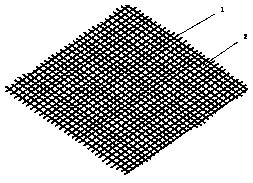Method for roll-to-roll continuous printing of OLED flexible display panel
A flexible display and printing method technology, which is applied in the field of OLED flexible panel preparation, can solve problems such as uneven printing, affecting the large-scale preparation of OLED flexible display panels, and loose bonding, so as to improve transmission efficiency, achieve controllable thickness and The precision is controllable and the effect of overcoming uneven printing
- Summary
- Abstract
- Description
- Claims
- Application Information
AI Technical Summary
Problems solved by technology
Method used
Image
Examples
Embodiment 1
[0038] (1) Feed the roll of polyimide film into the roll-to-roll continuous printing device, firstly by scraping, the polytetrafluoroethylene emulsion with a solid content of 40% dispersed in graphene is scraped on the polyimide film surface, and then pre-dried to make the coating liquid not flow; the mass fraction of graphene in the emulsion is 4%;
[0039] (2) After non-contact inkjet printing, such as figure 1 As shown, the hole injection material ink 2 tetrafluorotetracyanoquinodimethane ink, the hole transport material ink containing silica airgel 1 N,N'-diphenyl-N,N'-(1 -Naphthyl)-1,1'-biphenyl-4,4'-diamine ink is printed on the surface of the anode once alternately, and dried to form a hole transport layer; wherein the mass fraction of silica airgel in the ink is 0.5%;
[0040] (3) After non-contact inkjet printing, red, green, and blue luminescent material inks are printed on the surface of the hole transport layer according to high pixel settings, and dried;
[004...
Embodiment 2
[0045] (1) Feed the roll of polyimide film into the roll-to-roll continuous printing device, firstly by scraping, the polytetrafluoroethylene emulsion with a solid content of 40% dispersed in graphene is scraped on the polyimide film surface, and then pre-dried to make the coating liquid not flow; the mass fraction of graphene in the emulsion is 2%;
[0046] (2) After non-contact inkjet printing, 7,7,8,8-tetracyanoquinodimethane ink, N,N'-diphenyl-N,N containing silica airgel '-Bis(3-methylphenyl)-1,1'-biphenyl-4,4'-diamine ink is printed on the surface of the anode once and dried to form a hole transport layer; the ink contains silicon dioxide The mass fraction of airgel is 0.5%;
[0047] (3) After non-contact inkjet printing, red, green, and blue luminescent material inks are printed on the surface of the hole transport layer according to high pixel settings, and dried;
[0048] (4) Print the yttrium fluoride ink and 4,7-diphenyl-1,10-phenanthroline ink alternately on the ...
Embodiment 3
[0051] (1) Feed the roll of polyimide film into the roll-to-roll continuous printing device, firstly by scraping, the polytetrafluoroethylene emulsion with a solid content of 40% dispersed in graphene is scraped on the polyimide film surface, and then pre-dried to make the coating liquid not flow; the mass fraction of graphene in the emulsion is 3%;
[0052] (2) After non-contact inkjet printing, 4,4',4''-tris(2-naphthylphenylamino)triphenylamine ink, 4,4'-ring containing silica airgel Hexyl bis[N,N-bis(4-methylphenyl)aniline] ink is printed on the surface of the anode in one phase, and dried to form a hole transport layer; the mass fraction of silica airgel in the ink is 0.5% ;
[0053] (3) After non-contact inkjet printing, red, green, and blue luminescent material inks are printed on the surface of the hole transport layer according to high pixel settings, and dried;
[0054] (4) Print zinc oxide ink and 1,3,5-tris(1-phenyl-1H-benzimidazol-2-yl)benzene ink alternately on ...
PUM
 Login to View More
Login to View More Abstract
Description
Claims
Application Information
 Login to View More
Login to View More - R&D
- Intellectual Property
- Life Sciences
- Materials
- Tech Scout
- Unparalleled Data Quality
- Higher Quality Content
- 60% Fewer Hallucinations
Browse by: Latest US Patents, China's latest patents, Technical Efficacy Thesaurus, Application Domain, Technology Topic, Popular Technical Reports.
© 2025 PatSnap. All rights reserved.Legal|Privacy policy|Modern Slavery Act Transparency Statement|Sitemap|About US| Contact US: help@patsnap.com



